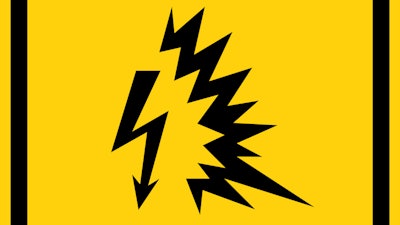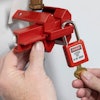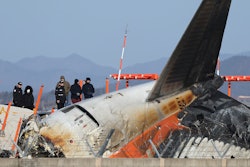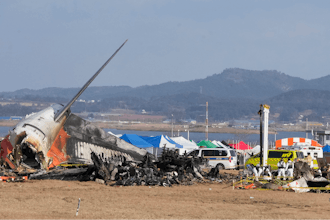
When preparing to work on electrical circuits, the best approach is to lock out/tag out (LOTO) the electrical energy source before beginning work. But when that’s not possible, electricians must expect and prepare for arc flash and shock hazards that exist when working on live equipment.
Unlike in a LOTO scenario, where all hazardous energy is identified, isolated, and eliminated prior to starting work, energized circuits present life-threatening challenges that require additional protection.
The need for such protection grows as you get closer to the energized equipment. In fact, arc flash events are so dangerous that even people far from the equipment are at risk unless they stay beyond the arc flash boundary.
What is an Arc Flash Boundary?
An arc flash can generate temperatures exceeding 35,000°F (19,400°C)—more than three times the surface temperature of the sun. So understanding the arc flash boundaries is crucial for safety. The arc flash boundary is the minimum safe distance from exposed energized circuits or conductor parts that could cause an arc flash event. It’s the distance where a person not wearing appropriate PPE could experience 1.2 calories/cm2 of incident energy in an arc flash event, which would cause second-degree burns or worse.
 Mechanix Wear
Mechanix Wear
Other Boundary Types
Arc flash incidents aren’t the only hazard electricians face when working with energized equipment. Shock hazards exist as well, with different risks at different distances. NFPA 70E-2021 guidelines define several types of boundaries based on energy levels, safe distance calculations, and required PPE and training.
- Limited Approach Boundary: the outermost boundary that identifies the farthest point at which a shock hazard exists, generally 36”-42” away. Only qualified (trained) electricians are allowed to enter this area while wearing the appropriate PPE. Entering this known hazard area also requires a completed electrical work zone permit, similar to working in confined spaces, hot zones, or at heights.
- Restricted Approach Boundary: this boundary lies within the limited approach boundary and defines the distance to energized equipment where a qualified electrician may enter without wearing PPE. In addition to the permit, employees working in this area must conduct an effective hazard or risk assessment and identify the specific hazards present before entering. Insulated tools are required to protect workers from electrical shock and arc flash hazards by preventing direct contact with live circuits.
- Prohibited Approach Boundary: this zone has the highest risk of severe or fatal injury. Breaching this boundary is considered to be the same risk as physically touching the exposed live part. As the name suggests, no one, regardless of training or skill level, is allowed to be within this established boundary while electrical components are energized.
How to Observe Arc Flash Boundaries
Research from the Occupational Safety and Health Administration (OSHA) suggests that clearly marking arc flash boundaries can reduce exposure to arc flash hazards by up to 80%, significantly lowering the risk of injury or fatality.
Whenever energized circuitry is exposed, such as when a cover is off a panel, an approach boundary surrounding the exposed equipment must be established. All the different types of boundaries (arc flash and otherwise) must be identified and visually marked or labeled based on the NFPA 70E-2021 requirements.
You must set up visual warnings to indicate the extended boundary parameters. Use cones, color-coded tape, or similar measures, placing them at the furthest point from the equipment. This ensures safety for both the person performing the task and others nearby. You are signaling that an additional hazard has been introduced into the work zone and that everyone must stay clear of the boundary area while these visuals are in place. Within the arc flash boundary, equipment must be labeled with specific warnings, distances, and PPE categories needed to work within each boundary.
How Boundary Ranges Are Calculated
You can base the boundary range on NFPA 70E requirements or have a qualified person, such as an electrical engineer or third-party specialist, calculate it. An arc flash boundary can range from six to twenty feet or more.
Qualified workers remove covers, inspect the area, examine the types of breakers and wire sizes, and log the information. Then, they send the data to an electrical engineer to calculate the incident energy. This is an extremely important assessment, as it identifies the level of danger.
If the equipment in your location has already been analyzed and labeled, follow the labels! Don’t use new or updated electrical equipment until it’s analyzed, labeled, and floor markings are set. All of that should be part of the installation process and never left unchecked. Often, the equipment manufacturer or installer can provide the assessment or already knows the AF boundary requirements.
It’s possible to calculate boundaries yourself using published tables, but based on how much risk and potential for lethal injury is involved, you should only use this to provide an initial set of boundaries. Don’t fully trust it without having an electrical engineer or specialist conduct a thorough risk assessment. Instead, use the published tables as a starting point to identify equipment that requires in-depth analysis over those that pose little to no arc flash risk.
Note that not all electrical equipment has arc flash potential, so it’s important to obtain an incident energy analysis and apply the appropriate equipment label to indicate the voltage, arc flash boundary, and necessary PPE. If there is no arc flash hazard, label it to indicate that, preventing miscommunication and undesired behaviors. According to Electrical Safety Foundation International, inadequate labeling is responsible for over 30% of arc flash incidents. Regular maintenance and inspection of labels can prevent this common issue and save lives.
Establish a regular schedule as part of a preventative maintenance plan to inspect labels. Employees should also inspect labels before starting work to ensure they are legible and accurate. Never assume equipment is safe if it’s not properly labeled.
Choosing the Right PPE
Once you identify the hazards, establish the boundaries, and have the labels and safety protocols in place, how do you determine the best PPE for your specific needs, location, and hazards?
The incident energy analysis results can help you select the PPE that best matches the predicted hazards. Arc flash PPE is categorized into four protection levels based on the energy involved in an arc flash incident (usually expressed as cal/cm²). Low-energy (8 cal/cm²) and lower-risk arc flash events require Cat 1 PPE, while high-energy arc flash incidents (40 cal/cm²) demand Cat 4 PPE, the highest available.
For example, Mechanix Wear offers a Cat 4 Arc Flash Suit that integrates arc-rated PYRAD® by GORE-TEX LABS. It’s an extremely lightweight garment that allows electrical workers to stay focused and productive for a longer time without the fatigue associated with heavier, warmer solutions.
If you are unsure about what level of protection your facility requires, Mechanix Wear offers the Track Program—a free on-site safety assessment during which a trained safety experts will conduct a facility walkaround and provide task-specific safety recommendations, PPE wear trials, and ongoing consultation and support.
Randy DeVaul is an experienced safety professional providing safety support to employers virtually and onsite. As a freelance safety writer, Randy is published in trade publications across the globe. He currently writes on behalf of Mechanix Wear, a global PPE manufacturer.






















